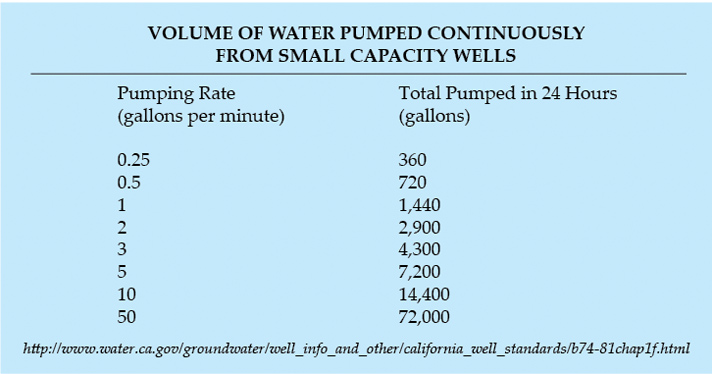On Real Estate & More – June 2017
Many households in rural areas of Oregon obtain their water from a well. The question that always comes up in real estate transactions is how much water does the well produce and how much do you need?
The amount of water needed will yield various results, though some websites state a minimum of 3-5 gallons per minute is desired. Besides the actual volume of water a well can produce, there are other factors to consider when purchasing a property, including peak usage, water storage, water conservation methods, as well as availability of other sources of water, such as properties with irrigation rights.
According to the US Environmental Protection Agency, the average American family uses more than 300 gallons of water per day at home. Roughly 70 percent of this use occurs indoors. Nationally, outdoor water use accounts for 30 percent of household use yet is much higher in drier parts of the country such as the Rogue Valley, and in more water-intensive landscapes.
The City of Ashland conducted a Water Conservation and Reuse Study in 2010 which found Ashland residents utilize an almost equal amount of water for outdoor use as indoors (49.5% outdoor, 50.5% indoor) averaged over the year, with the peak outdoor use towards the end of June.
The table below shows the volume of water supplied from a well, assuming continuous pumping for 24 hours. According to this table, a well supplying ½ gallon per minute (gpm) would be an adequate amount for a single family dwelling for an average family size, though ½ gpm would be considered a low-yielding well.
Dealing with low-yielding wells requires an understanding of peak demand. A well that yields only ½ gallon per minute of water can still produce 720 gallons of water in a day. However, water use in a home or farm does not occur evenly during the day. There are peak usage times, typically during the morning and/or evening, when water demand is very high. These peak demand periods usually last from 30 minutes to two hours. An adequate water system should yield enough water to satisfy a peak demand period. If an existing well does not meet peak water demand you can increase the storage within the water system by adding a water storage (holding) tank.
A holding tank will have a float in the tank set to start the submersible pump (located in the well), when the water level in the tank reaches a certain level to maximize the storage capacity in the holding tank constantly. In a typical day you may see the float switch turn on to fill the holding tank maybe several times. The important part of this and any holding system is to be able to store large amounts until needed so you are not demanding water as it flows into the well.
Peak water demands can also be reduced by changing the timing of water-using activities or by reducing the amount of water used. An example of changing the timing of water use is spreading laundry loads throughout the week instead of doing all loads in one day.
Reducing the amount of water used involves water conservation which can include items such as taking shorter showers, or installing water-saving devices like front-loading clothes washers or low-flush toilets. The use of a front-loading washer alone will save more than 20 gallons of water for each load of laundry. Installation of water-saving devices and appliances can reduce household water use by up to 30 percent and also save hundreds of dollars per year in energy used for heating water.
An additional item to consider with the amount of water needed for a property has to do with irrigation rights. Properties with irrigation rights have less of a demand on their well since the water for outdoor use, which can be considerable, comes from the irrigation source.
And lastly, make sure you do your due diligence before purchasing a property with a well and that you are comfortable with the findings.


 Sandy J. Brown lives in Jacksonville and is a real estate broker and land use planner with Windermere Van Vleet Jacksonville. She can be reached at sandyjbrown@windermere.com or 831-588-8204.
Sandy J. Brown lives in Jacksonville and is a real estate broker and land use planner with Windermere Van Vleet Jacksonville. She can be reached at sandyjbrown@windermere.com or 831-588-8204.